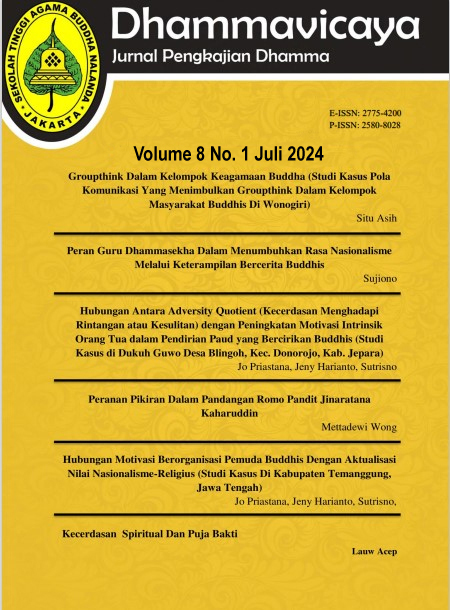Pengaruh Motivasi Belajar dan Inovasi Organisasi terhadap Hasil Belajar Agama Buddha Siswa SMA Denpasar
DOI:
https://doi.org/10.47861/dhammavicaya.v8i1.1639Keywords:
Learning Outcomes, Motivation, Organizational InnovationAbstract
Learning outcomes are important for a child to be able to have the ability and also have knowledge.This study uses quantitative research methods. Data collection techniques in quantitative research use a questionnaire developed through the indicators of each variable. The results of hypothesis testing the effect of the functional relationship (X1) on (Y) with the regression equation = 23.349 + 0.812 X1, (2) There is an influence (X2 ) on (Y) with the regression equation = 23.749 + 0.827 X2, (3) There is an influence (X1) and (X2) together on (Y) with the regression equation = 24.159 + 1.229 X1 – 0.483 X2. The regression coefficient value of Learning Motivation (X1) is 0.812, meaning that if the Learning Motivation variable (X1) increases by 1% assuming Organizational Innovation (X2) and Constant (a) is 0 (zero) then Learning Outcomes (Y) increase by 0.812, p. it shows that the learning motivation variable (X1) contributes positively to the learning outcomes (Y) so that the students' learning motivation (X1) will increase the students' learning outcomes (Y).
References
A.M. Sardiman. (2011). Interaksi dan Motivasi Belajar Mengajar. PT Rajagrafindo: Jakarta.
Abin Syamsuddin Makmun. (2012). Psikologi Kependidikan Perangkat Sistem Pengajaran Modul. Bandung: Remaja Rosdakarya.
Ahmed, P. K., & Shepherd, C. D. (2010). Innovation Management. New Jersey: Pearson Education, Inc.
Bhikkhu Jotidhammo. (2013). Membangun Etos Kerja Buddhis. BUDDHA CAKKHU, 19(XI), 90. Yayasan Dhammadipa Arama.
Coyne, W. (2004). Innovation as a Competitive Advantage. Lengnick Journal of Management.
Djamarah, S. B. (2002). Psikologi Belajar. Jakarta: Rineka Cipta.
Drucker, P. F. (1985). Inovasi dan Kewiraswastaan: Praktek & Dasar-Dasar. Jakarta: Erlangga.
El, I. K. (2017). Belajar Dan Pembelajaran. Yogyakarta: Pustaka Pelajar.
Everett M. Rogers. (1983). Diffusion of Innovations. London: The Free Press.
Hamzah B. Uno. (2011). Teori Motivasi dan Pengukurannya: Analisis Di Bidang Pendidikan. Jakarta: Bumi Aksara.
Harvard Business Essentials Series. (2003). Managing Creativity and Innovation. America: Harvard Business School Publishing Corporation.
Hidayat, N., Sutrisno, S., & Permatasari, T. (2023). Transformasi Sekolah Tinggi Agama Buddha Nalanda menjadi Institut Agama Buddha Nalanda: Tinjauan Studi Kelayakan dalam Konteks Sosial Budaya. Innovative: Journal of Social Science Research, 3(5), 4174–4189. Retrieved from https://j-innovative.org/index.php/Innovative/article/view/5331
J. Greenberg, & R. A. Baron. (2008). Behavior in Organizations. Upper Saddle River, NJ: Pearson Prentice-Hall, pp. 568-572.
Majalah Buddha Cakkhu. (1991). Edisi Magha 2534. Dhammadipa Arama Jakarta.
Mary Uhl-Bien, John R. Schermerhorn, Jr., & Richard N. Osborn. (2014). Organizational Behavior. New York: John Wiley & Sons, pp. 342.
Mohandas, R., Widyastono, H., & Purba, M. (2014). Pedoman Guru Mata Pelajaran Pendidikan Agama Buddha dan Budi Pekerti. Jakarta: Pusat Kurikulum dan Perbukuan Badan Penelitian dan Pengembangan Kementrian Pendidikan dan Kebudayaan.
Nana Sudjana. (2014). Penilaian Hasil Proses Belajar Mengajar. Bandung: Remaja Rosdakarya.
Paul A. Schumann, Jr., et al. (1994). Innovate! : Straight Path to Quality, Customer Delight, and Competitive Advantage. New York: McGraw-Hill.
Rizqiani, W., & Hidayat, N. (2024). Low Public Perspective on The Importance of a Sustainable Environment in The Environmental Journalism Polemic. International Journal of Environmental Communication (ENVICOMM), 1(1), 32-40. https://doi.org/10.35814/envicomm.v1i1.7874
Sidow, M. A., & Ali, A. Y. S. (2014). Corporate Innovation and Organizational Performance: The Case of Somalia Telecommunication Industry. International Journal of Business, Economics and Law, 4(1), June.
Slameto. (2010). Hasil Belajar dan Faktor-Faktor yang Mempengaruhinya. Jakarta: Rineka Cipta.
Soepandi, Y., & Hendrian, Y. (2020). Peran Kesadaran /Sati Terhadap Minat Baca Belajar Peserta Didik Di SMB Trisaranagamana. Jurnal Ilmu Agama dan Pendidikan Agama Buddha.
Stephen P. Robbins. (2003). Organizational Behavior. New York: Prentice Hall, pp. 571-572.
Sudjana, N. (2008). Penilaian Hasil Proses Belajar Mengajar. Bandung: Penerbit Remaja Rosdakarya.
Sugiyono. (2011). Metode Penelitian Kuantitatif, Kualitatif dan R&D. Bandung: Alfabeta.
Supardi. (2015). Penilaian Autentik Pembelajaran Afektif, Kognitif, dan Psikomotor. Jakarta: PT Raja Grafindo Persada.
Syah, M. (2011). Psikologi Pendidikan dengan Pendekatan Baru. Bandung: Remaja Rosdakarya.
West, M. A. (2000). Mengembangkan Kreativitas Dalam Organisasi (Edisi Terjemahan). Yogyakarta: Penerbit Kanisius.
Worrell, J., & Stiwell, W. E. (1981). Psychology For Teachers and Students. New York: McGraw-Hill Book Co.
Downloads
Published
How to Cite
Issue
Section
License
Copyright (c) 2025 Dhammavicaya : Jurnal Pengkajian Dhamma

This work is licensed under a Creative Commons Attribution-NonCommercial-ShareAlike 4.0 International License.






